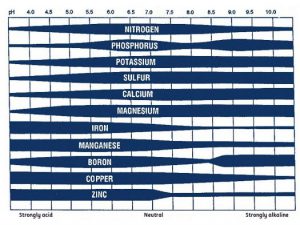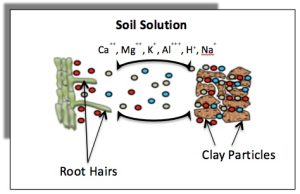Managing your soil is easily the most critical task in gardening. Well-managed soils retain water and nutrients, making them available to your plants, thus enabling them to thrive. It may seem daunting, but with a bit of knowledge, you’ll quickly discover that soil management is much simpler than you thought. Soil management can be broken down into two major topics. The first is the physical properties outlined in a previous article, which may be found here. The second, and arguably more complicated of the two, are those chemical properties that drive plant growth.
The What and Why of Soil pH
When considering chemical properties, you first need to look at soil pH. This is the measure of acidity or alkalinity within your soil profile. Innate soil pH is a product of the parent material from which your soil has formed, which tends to be slightly acidic on the Panhandle. Testing is the only accurate way to measure your soil’s pH level and buffering capacity. Your county extension office will be happy to facilitate that testing.
So, why is pH so important to plant growth? You’ll want to manage your soil’s pH for two reasons. The first is that soil acidity greatly influences the form that fertilizers and herbicides take in your landscape. Put into context, if you add fertilizers into the soil with an incorrect pH, that fertilizer may not dissolve in the water present. It will thus be unavailable to your plants. Here is another example of putting the right plant in the right place. Some, such as centipedegrass, thrive in a low-nutrition environment created by a low pH, whereas most vegetable plant species and many other landscape species only want a slightly acidic environment. Placing plants that will grow in the natural pH of your soil is a great way to ensure success in your gardens.
Ok, you’ve tested your soil and discovered it is not optimal for the plants you want to grow. Fear not, as you can take some actions to adjust your soil’s inherent acidity levels. Keep in mind that any changes will be very localized and are temporary. To raise soil pH, you must apply some version of calcium, colloquially called liming. Your calcium source should be based on soil testing, as different types may also add needed nutrients. Most notably, dolomitic lime will change soil pH while adding magnesium. Soil testing will also tell you to provide the buffering capacity of your soil, which will dictate the amount needed to adjust the soil properly. Soil pH may also be lowered through elemental sulfur additions, but this process is very difficult and may become detrimental to plant growth through repeated application. In this instance, it may be preferable to address via plant selection versus pH adjustment.
How Does Soil Hold Onto Water and Nutrition
The other main consideration for soil chemical properties is cation exchange capacity or CEC. Now, this can be a very complicated topic. Put very simply, it refers to your soil’s ability to retain both water and applied nutrients. It’s important to understand as it holds components critical to plant growth in the root zone of said plants. This happens as there are negative charges on the surfaces of clay particles in your soil that latch onto the positive ions of applied fertilizers.
So, what about soils low in clay, such as those in Florida? Organic matter will help in this arena. It mimics clay’s properties and will retain nutrients better than your native soil. However, this is not a pass to add endless amounts of compost, as they come with a nutritive load that must be considered in your garden management plan. Adding 1-3 inches worked into your plant root zone is more than enough when establishing new gardens.
Understanding your soil is critical when gardening anywhere. In Florida, where soils are less than optimal, understanding how water and nutrients are retained and used by your plants will help avoid much frustration. For more information on soil management refer to these IFAS documents, or contact your local extension agent for additional information on this and any topic regarding your gardens and more.
- Cold Protection for North Florida - November 6, 2025
- Planning and Planting for Wildlife - October 10, 2025
- Why Say No to Invasive Species - August 23, 2025


